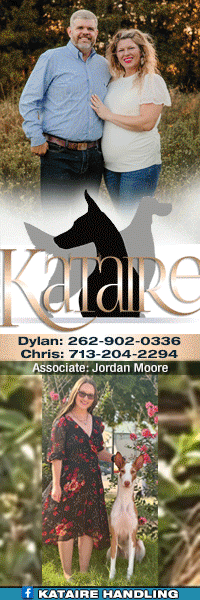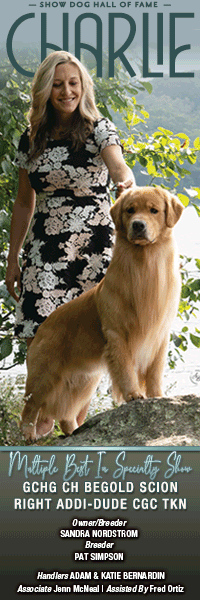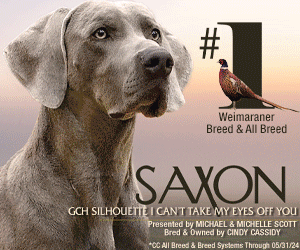Dr. Gerda M. Kennedy – Vun More Time…
244 – April, 2013 Click here to read the full article in our digital edition.
From the archives of The Canine Chronicle
By Trisha Murphy-Horman, Sharrah Afghans, est. 1971
“Vun more time a-vound da ring!”, Judge Dr. Gerda Kennedy commanded in her native Austrian tongue.
As she twirled her long pointer finger, only brave, hard-bodied individuals dutifully ran around her ring. They hoped for a coveted win, usually with bragging rights, from the great Dr. Kennedy. Though her ring etiquette was taxing, there was a sincere acceptance for the unskilled exhibitor with a superior dog. Young, old, male, and female were charmed by her, because she had the ‘it factor.’ While exhibitors loved her, kennel clubs suffered because she was thorough and overshot time constraints. It hurt her marketability, but made the win more special. Gerda was impeccably dressed, usually in a white suit that never soiled. I imagine if she took a mountain hike dressed like that, she would return fresh and spotless. Amazing. The stately woman stood proud and uniquely different from other breeders, owner-handlers, and judges. As she judged in adverse conditions, even howling winds and driving rain left her untouched, like a biblical character parting the sea. She nary had a hair flip out of place. What was that magic spray? When judging, she had a critical eye for dogs in general, but she is gone. Dr. Kennedy survived a massive stroke January 17, but lost the battle on February 2, 2013 at the age of 93.
Born in Rohitsch Sauerbrunn, Austria on September 25, 1919, Gerda came to the U.S. in 1948, escaping the devastation of war. She became a naturalized citizen in 1958. She did not practice medicine in the U.S, and in 1960 married Bill Kennedy, of Kennedy Engineering. In 2001, she had a heart valve replacement, and then sold the ranch in Broken Arrow, Oklahoma, the birthplace of Shangrila Afghans. She moved to an independent living facility in Edmond, Oklahoma. She is survived by her daughter, Irene McPheron, of Edmond, Oklahoma and son, Louis Shaffer of Victor, New York. Her grandchildren are Aaron Hillhouse and Christa Hillhouse and Matthew Dean Shaffer and great-grandchildren are Ryan Hillhouse, Brandon Hillhouse, and Victoria Shaffer.
Shangrila Afghans, established in the ‘60s, was revered as one of the TOP places to purchase an Afghan. The name in the movie and place in the Himalayas were as magical as the fountain-of-youth connotation, but in reality the range was close in proximity to where Afghans originated. The Shangrila name was as mystifying as the private, stoic Gerda Kennedy, who rarely granted interviews. Her line was comprised of Akaba Afghans, from Lois Boardman, and Scheherezade Afghans, from Lt. Col. Wally Pede. Gerda added Swedish blood from Cynthia Guzevich’s Joh-Cyn line.
In addition to Afghans, Gerda also added Borzoi and Lipizzan horses. Per daughter, Irene, “Mother did buy two Lipizzan mares from Austria around 1970. They were both older mares that were bred in Vienna and then shipped to mother. However, only one of the mares had a foal and mother named him “His Majesty”. The two Lipizzan mares both did have the original “royal crest” which did prove that they were both from original Lipizzan stock from Austria. I have all paperwork – the horses are long gone now.”
As a breeder-owner-handler, Gerda achieved 13 Best In Shows on extreme mover, Ch. Shangrila Pharahna Phaedra, whelped in 1967. The exotic black and silver bitch, with long silk coat, held the title of #1 Afghan bitch of all time for many years. When she retired in ’72, she amassed 4 Specialty wins (there were less specialties then), 49 Group 1s, 21 group placements with 80 breed wins. Group 1s comprised 61% of her wins, and 76% were total Group placements. Phaedra was out of Am. Ch. Sandhihi Joh-Cyn Taija Baba x Ch. Shangrila Pharahna Cleopatra.
It was hard to deny Gerda and Phaedra. They were perfection. Deafening silence dominated as Gerda effortlessly lead Phaedra around the BIS ring. When the bitch hit her stride and went into double suspension, it typified pure kinetic balance. She floated and spent more time in the air than on the ground; it was machine-like and powerful. People jerked back awestruck. One time, Phaedra pulled Gerda off the mat and gaited to middle of the ring then hopped up on the BIS podium and self-stacked; she then panned the lowly humans. The crowd applauded, hooted and cheered with approval. Yes, she won that one, too. I was honored to sign the back of that 13th BIS rosette, and it was her last. It became a “freeze-frame” moment and started in motion my direction in Afghans.
I witnessed Gerda’s command, “Phaedra wee-wee”, and voila! The sweet thing looked up devotedly at Gerda then went on the single paper towel sheet. Phaedra would go on a bumper, if so directed. With a short 2 year campaign, Phaedra retired at age 5. Then Gerda’s quest started to breed her stunning girl. Much time was spent flying back and forth from Oklahoma to Illinois, my home state, where reproduction specialists worked diligently with Dr. Kennedy. Ultimately, Phaedra produced a small litter of 2 bitches and 1 male. They were not the best quality. As Gerda said, “Sometimes the genes are not kind, dah-ling.” It was then she began to discuss her struggles climbing to the top. It was as though she became liberated talking about it. She was a woman breeder-owner-handler in a man’s world and helped break the mold for women to follow.
Though Gerda had many Shangrila champions, her other heart tug was elegant and rangy, highly marked black and tan, Ch. Shangrila Pharaoh Gandharra (Ch. Sasha of Scheherezade x Ch. Akaba’s Royal Gold). I walked him at the same show as Phaedra’s last BIS in Michigan. Those were amazing times in the kingdom with Phaedra and Gandharra. Gerda commanded the utmost in respect, and her entourages eagerly complied.
In the mid-70s, Gerda stopped exhibiting and breeding to judge because she had a strong belief regarding conflict of interest. Though many people today do both, the clean break was non-negotiable for Gerda. Since collecting semen was non-existent, she did not preserve Shangrila’s lineage. That’s when she began her mantra about gene pool. Certain actions and reasons for operating as she did molded my direction in Afghans even more.
Elegance in the ‘70s from Shangrila Afghans was unique. It was called “the look” and it was undeniable. My first Ch. Afghan, Ch. Shangrila Pharaoh Kauravya, won an art contest because of that LOOK. The award was an original 24 x 36” Virginia Szekula that resides on my ‘wall of fame’. Shangrila’s elegance and Gerda’s dedication to line breeding and gene pool I cannot stress enough, and I will come back to it. Type and movement were also vital. Blending these elements, as a breeder, along with Gerda’s exceptional grooming and exhibiting skills, as well as later when she transitioned into the judging realm, put her on the map forever. The combination of the aforementioned solidified my path.
Gene pool: Gerda repeated over the decades, “pick a line and stick with it.” No, she beat me over the head with it! She emphasized that was the ONLY way to preserve the Afghan Breed and stressed establishing a line, growing a gene pool and, more importantly, maintaining it. The maintenance aspect separated the true breeder from the chaff, she insisted. She claimed those who bred to a dog linked to their dog more than 3 generations kidded themselves. The gene pool had to “march forward” with each generation. She believed in two line breedings, (one in-breeding could be one of the two), the third should be an outcross with a dog that possessed a portion of the line. I call it ‘outcross light.’ That was Gerda’s ‘secret sauce’ for a gene pool. My first Afghan, Ch. Kauravya (yes, one of “the look” dogs), was out of Shangrila Pharaoh Kama (a Ch. Gandharra son) x Ch. Shangrila Pharahna Uvasa (a full Ch. Gandharra sister), and it was a tight line breeding. Whether one liked Shangrila dogs or not, most serious breeders appreciated Gerda’s efforts as an art form. But, she had acreage and few constraints; therefore, she had many dogs to develop a gene pool.
In her later years, we discussed the decline in Afghans. When she exhibited, 16 dogs were needed for 1 point, now it is 2. As a judge, she experienced people bringing many dogs from a kennel to create majors to finish inadequate stock. When she took those 80 Breeds with Phaedra, she consistently defeated 50-100 dogs (in ’72 it took over 71 males and 70 bitches for a 5-point Major). Still, she pressed me to stay the course and educate.
While some judges today appreciate standard-sized, square, level-topped, deep-chested, open moving dogs, others award over-standard, slab-sided ones with poor front assemblies, high withers and bad toplines. Gerda felt it was the breeder’s responsibility first, but the judge must know a given breed well to excuse and educate where necessary. It should not be about assignments, but the dogs, but the trend has changed. Gerda had judge friends who refused to play the proverbial game then suffered with additional assignments. Those that participated gained power, income, and more judging invites. Gerda claimed judges were indirectly encouraged, by the AKC and/or reps, to put up the handlers. At first I did not believe her, but upon investigation, I believed it to be true. She felt it was harder than ever for a breeder-owner-handler (like me) to get in the Top 10 and maintain that status. Gerda had a strong opinion that dog shows are no longer about the dogs, but about the numbers and money. She was frustrated by such “shenanigans” and said it destroyed what the AKC once stood for – to work in the best interest of purebred dogs.
I talked with Gerda at Christmas and was ready to call her after the Chicago International. I was excited to tell her about my exciting special (84 crosses to her famed, Ch. Gandharra). In 3 outings, he started out the year with 2 more Group placements (total of 9), and was in the Top 10. Those 2 recent Group placements were from iconic Afghan judges as well. She respected both of those individuals, but repeatedly over the past 10 years stated one, “was a hard nut to crack.” Well, I did it! Gerda, was full of delight when I called… maybe longing for those days with Phaedra.
We also discussed dancing in Austria (she was a Waltz princess in Vienna), her safari, breeding, showing, raising kids, art, music, and vitamins. Yowza! She liked those vitamins! Claimed she had the mind of a 60 year-old, so she tried to sell them to everyone. Regardless, like an attentive student, I took notes, and that’s why I have the information for this tribute. She would repeat stories she embellished and I never stopped her. I chuckled; she was a character.
After 42 years in Afghans and 8 Sharrah generations, having the first confirmed case of Parvo in the Midwest (yes, I am the one who started the fund and campaign and raised over $1 million for Cornell), then becoming the “Logansport Girl” (yes, again, and after that assault, judges must sign their books before handing out ribbons), going through challenges with Gerda early on, and communicating with her consistently in the past decade, will remain special. Though Dr. Kennedy was not a Parent Club member, Afghans and the dog world lost a grand lady and a tower of strength; the aura around her memory lingers.
Go around the ring, Gerda… one last time.

Short URL: http://caninechronicle.com/?p=22149
Comments are closed















